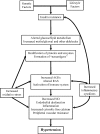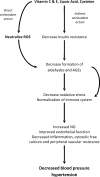Role of the immune system in hypertension: modulation by dietary antioxidants
- PMID: 23204821
- PMCID: PMC3331645
- DOI: 10.1055/s-0031-1288941
Role of the immune system in hypertension: modulation by dietary antioxidants
Abstract
Hypertension is a major health problem worldwide. Individuals with hypertension are at an increased risk for stroke, heart disease, and kidney failure. Although the etiology of essential hypertension has a genetic component, lifestyle factors such as diet play an important role. Insulin resistance is a common feature of hypertension in both humans and animal models affecting glucose and lipid metabolism producing excess aldehydes including methylglyoxal. These aldehydes react with proteins to form conjugates called advanced glycation end products (AGEs). This alters protein structure and function and can affect vascular and immune cells leading to their activation and secretion of inflammatory cytokines. AGEs also act via receptors for advanced glycation end products on these cells altering the function of antioxidant and metabolic enzymes, and ion channels. This results in an increase in cytosolic free calcium, decrease in nitric oxide, endothelial dysfunction, oxidative stress, peripheral vascular resistance, and infiltration of vascular and kidney tissue with inflammatory cells leading to hypertension. Supplementation with dietary antioxidants including vitamins C, E, or B(6), thiols such as cysteine and lipoic acid, have been shown to lower blood pressure and plasma inflammatory cytokines in animal models and humans with essential hypertension. A well-balanced diet rich in antioxidants that includes vegetables, fruits, low fat dairy products, low salt, and includes whole grains, poultry, fish and nuts, lowers blood pressure and vascular inflammation. These antioxidants may achieve their antihypertensive and anti-inflammatory/immunomodulatory effects by reducing AGEs and improving insulin resistance and associated alterations. Dietary supplementation with antioxidants may be a beneficial, inexpensive, front-line alterative treatment modality for hypertension.
Keywords: Hypertension; T cells; advanced glycation end products; dietary antioxidants; immune system; inflammatory cytokines; insulin resistance; macrophages; oxidative stress; receptors for advanced glycation end products; renal damage; renin-angiotensin system.
Figures


References
-
- World Health Organization Available at: Chronic Disease- key risk factors include high cholesterol, high blood pressure, low fruit and vegetable intake. http://www.who.int/dietphysicalactivity/publications/facts/riskfactors/en/ Accessed June 9, 2010. http://www.who.int/dietphysicalactivity/publications/facts/riskfactors/en/
-
- World Health Organization World Health Organization. The World Health Report [chapter 4] Geneva: World Health Organization; 2002. Quantifying selected major risks to health; pp. 1–13.
-
- He J, Whelton P K. Epidemiology and prevention of hypertension. Med Clin North Am. 1997;81(5):1077–1097. - PubMed
-
- Klag M J, Whelton P K, Randall B L, et al. Blood pressure and end-stage renal disease in men. N Engl J Med. 1996;334(1):13–18. - PubMed
-
- Deshmukh R, Smith A, Lilly L S. Hypertension. In: Lilly L S, editor. Pathophysiology of Heart Disease. 2nd ed. Philadelphia: Lippincott Williams and Wilkins; 1998. pp. 267–288.
LinkOut - more resources
Full Text Sources
Medical

